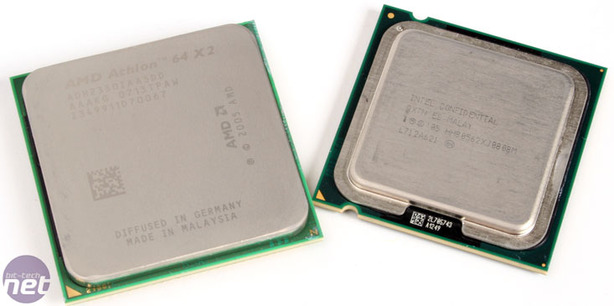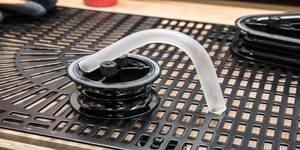
Water...what?
In order to understand the forces at work in our system, one thing is greatly important - an understanding of why water works in the first place. And the best place to start explaining that is to explain why air doesn't. So, before we go into water cooling, let's take a look at how air cooling functions.Traditional air-cooling works by using a large block of metal (your heatsink), and usually a large fan to go with it. That chunk of metal is placed on top of the heat spreader for your chip, usually with a middle layer of (hopefully) very thinly applied thermal paste. Heat then passes through the heat spreader and to the heatsink which generally consists of many, many thin fins. These fins get air passed through them, and the heat goes from the molecules of the heatsink to the molecules in the air.
How effective is this? Well, for that, we start off by looking at the ultimate governing rule of cooling - Newton's Law of Cooling. "For a body cooling in a draft, the rate of heat loss is proportional to the difference in temperatures between the body and its surroundings."
So, if our CPU is 60 degrees Celsius and our ambient air is 25, things should cool off nicely, right? Well, sure, right up until we hit the concept of...
Specific Heat
Specific heat is really not a scientific figure in and of itself, but more of a derivative of a concept. But that's okay - it's a handy little number that is great to relate things to one another. The term is derived from how much energy it takes to heat one unit of a compound by one degree as compared to water (which is always a specific heat of 1).Air has a specific heat of right around 0.23, meaning that it takes about four times less energy to raise it up by a degree than an equal weight of water. Or, in a more useful description, water can absorb four times more of that 125W TDP your processor is cooking up for you than air. In equal measure, you'd be able to cool a quad-core QX6850 on water as well as you can cool a 35W A64 on air. Cool, huh?
Even better is, that's only half the story. Because next up is...

The 45W AMD BE-2350 versus 130W Intel QX6850
Thermal Capacity
Thermal Capacity is a handy, if complicated little animal. There is a calculation to derive the capacity of any homogeneous compound, be it an alloy, fluid mixture or pure element. Leaving out complicated measurement units and the afore-mentioned calculation, we can skip right to the numbers.Like Specific heat, TC is a great reference point for comparing two compounds - such as, .60 and .025. That's the TC of water and air, respectively. Just in case you're curious (and you wouldn't be reading this if not), copper has a TC of 401 - the second highest of all metals. Got a guess for the top one? If you said gold, you win...nothing, because it's only got a TC of 318. Silver actually has the highest, at 429. If you want better than that, you'll need to build your water blocks out of diamond (at over 900).
Anyhow, the higher the number, the faster and more readily a compound will absorb heat. Think of it like a determinant similar to electrical conductivity - either it carries current well (is a conductor) or it doesn't (is an insulator). As we can see here, water is almost 25 times better at conducting heat than air.
So...?
So what does all this mean? Well, it means that compared to air, water is a far superior coolant. It takes the heat on 24 times better than air, but stays colder four times longer. And as we learned from Newton, keeping that big temperature difference between the water and the CPU is incredibly important for keeping things cool to begin with.All that's missing is how to get the water onto the CPU heat spreader - and we use the same copper idea that we did for air here . This time, we just top it with a nifty block and run water through it. Tah-dah! There's the whole purpose of a water block. Most even have channels, pins or fins inside to increase surface area, just like air heatsinks.
Of course, that's really where the similarities end. Though air is also a fluid, water has some other problems that we have to tackle - not the least of which is the fact that it is in a liquid state and thus much heavier than air. So maybe we have a few more concepts to cover before we get to the cooling...

MSI MPG Velox 100R Chassis Review
October 14 2021 | 15:04








Want to comment? Please log in.